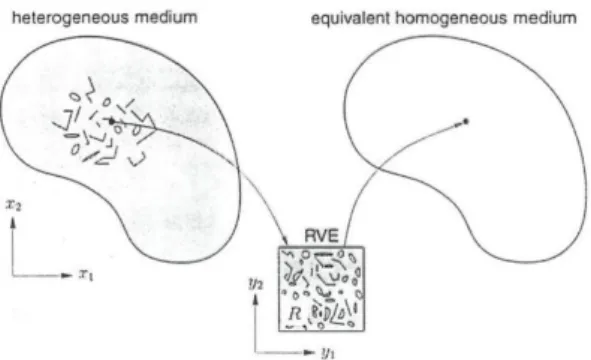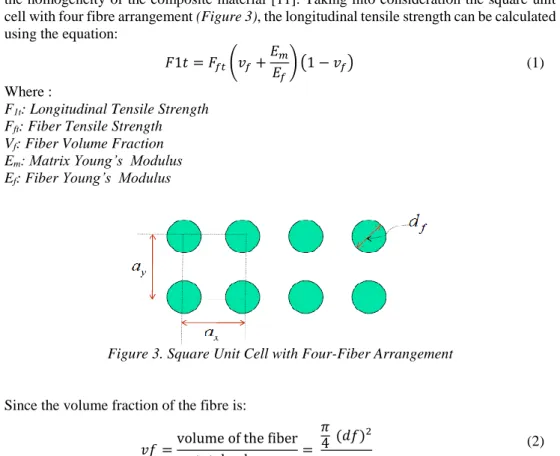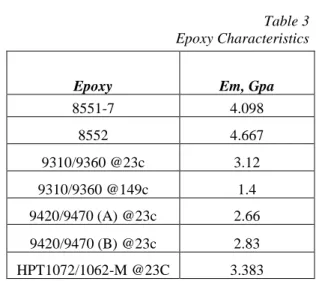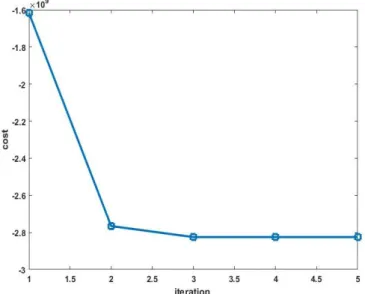DOI: 10.32972.dms.2019.001
OPTIMISATION OF THE FIBRE SIZE FOR A FIBER GLASS – EPOXY COMPOSITE
SAAD ALSARAYEFI–HAZIM NASIR GHAFIL–KÁROLY JÁLICS University of Miskolc, Department of Machine and Product Design
3515 Miskolc-Egyetemváros machsa@uni-miskolc.hu
Abstract: In this paper, swarm intelligence optimisation algorithms are used to estimate the optimal size of the glass fibre of circular cross-section of a glass-epoxy composite. Finding the best fibre size in a composite material has significant benefits on cost reduction. A comparative study was done to select optimal fibre diameter that can satisfy the optimal longitudinal tensile strength. Particle swarm optimisation algorithm PSO and artificial bee colony algorithm ABC are proposed for this comparative study.
Keywords: Optimisation, Composite material, Homogenisation
1. INTRODUCTION
Fibre reinforced composite is a rapidly growing class of materials because of the importance of having low weight with high strength material. Mainly, polymer matrix reinforced with fibres, such as glass, carbon, or aramid is extensively used in almost all engineering sector applications. As a reinforcement, the fibre is the most commonly used with ceramics, metals, and polymers to have materials with the advantages of high strength, stiffness, toughness, wear and corrosion resistance, and reduced cost.
From this, and over decades, many works of literature have been done to investigate the influence of the size of different types of fibres on the overall characteristics of the composite materials. S. T. Pinho et al. [1] studied the effect of fibre size on the strength and toughness of fibre reinforced composite. F. Ramsteiner [2] investigated the influence of fibre diameter on the tensile behaviour of short-glass-fibre reinforced polymers. Hamdullah Çuvalci [3], has researched the effect of a glass fibre content on the mechanical properties of a composite material. These researchers and others have confirmed that the fibre diameter has significant effects on the mechanical characteristics of the composite materials.
Glass fibre reinforced plastic (GFRP), e.g. Glass fibre/Epoxy is a class of plastic matrix composites that is reinforced by glass to mechanically enhance strength and stiffness of plastics. The resin (matrix) supports the fiber and adds more protection because of its ability of providing bonding between the two materials. As a result, GFRP presents flexible option for structural design due to its accessibility of manufacturing, high durability and stractural efficiency (strength to weight ratio), and low production cost [4, 5]. Thus, the GFRP use has significantly expanded to the structural parts of airplanes, automobiles, marine, civil construction industries, sport goods.
Although, when designing composite materials, it is normal to take the matrix characteris- tics into account, in such cases, the essential factors which make changes in the material features are fibre size (diameter, length), fibre orientation, fibre contents and others [6]. This work studies the relationship between the fibre diameter (optimum) and the longitudinal tensile
strength when designing materials based on representative volume element (RVE) or a unit cell, using an optimisation algorithm.
2. MULTI SCALE APROACH
Traditionally, simulation models were developed for one specific scale of magnitude (macroscopic, microscopic or nano). In practice, it would be impossible to compute the vibration simulation for GFRP parts in the micro scale, because of the very fine calculation model and the resulting huge number of elements. The general idea of the multi-scale approach is to de-fine a context between models of different scales by reasonably linking results of adjacent scales. The multi-scale approach is widely used in science [7].
In this case the multi-scale method is used to derive the material properties (Young’s modulus and density) in the macro-structure based on the detailed information in its micro- structure. The micro-structure corresponds to the scale in which heterogeneities can be modeled for several small and representative local sections of a part, while the macro structure of the part is modeled homogeneously with Young’s modulus and density values differing among defined sections.
In the macro scale model, it is assumed that the properties of each material point (node of the macro model) can be described by mapping information from a representative volume element (RVE). This approach was firstly suggested by Drugan and Willis [8]. This RVE contains the information of underlying the inhomogeneous micro structure. Original material properties like Young’s Modulus and density are used for a classical solid mechanic analysis of the inhomogeneous RVE. In a homogenization step substitute Young’s Modulus and density are determined for the RVE based on the equivalence of stress and strain. These new substitute properties are called Boundary Conditions (BC) for macro nodes and are mapped to the relevant nodes of the macro scale model (Figure 1).
Figure 1. Overview of Multi-scale approach
A Mean-Field Homogenization (MFH) is used in this step, which is based on the relation between volume averages and stress or strain fields in each phase of a RVE. In first-order homogenization substitute materials are computed with real constitutive rules (constant volume, density and energy). A typical example of MFH is the Mori–Tanaka model [9] which is successfully applicable to two-phase composites with identical and aligned with ellipsoidal inclusions. The single inclusion problem (2D) was solved analytically by J. D. Eshelby [10].
3D application has to be solved numerically (double inclusion problem). The model assumes
that each inclusion of the RVE behaves as if it was alone in an infinite body made of the real matrix material. The BCs in the double inclusion problem correspond to the volume average of the strain field in the matrix phase of the real RVE.
Depending on the possible periodic distribution of the fibre in the composite materials, the RVE or unit cell might be of square or hexagonal packing array as shown in Figure 2 [11].
Figure 2. Schematic Representation of Unit Cells
In the theory of composite materials, the unit cell is modelled based on assumption such as the homogeneity of the composite material [11]. Taking into consideration the square unit cell with four fibre arrangement (Figure 3), the longitudinal tensile strength can be calculated using the equation:
𝐹1𝑡 = 𝐹𝑓𝑡(𝑣𝑓+𝐸𝑚 𝐸𝑓
) (1 − 𝑣𝑓) (1)
Where :
F1t: Longitudinal Tensile Strength Fft: Fiber Tensile Strength Vf: Fiber Volume Fraction Em: Matrix Young’s Modulus Ef: Fiber Young’s Modulus
Figure 3. Square Unit Cell with Four-Fiber Arrangement
Since the volume fraction of the fibre is:
𝑣𝑓 =volume of the fiber total volume =
𝜋 4 (𝑑𝑓)2
𝑎𝑥. 𝑎𝑦 (2)
A direct relationship exists between the fibre and the longitudinal tensile strength.
3. C
LASSIFICATION AND CHARACTERISTICS OF THE GLASS FIBERThe two phases of the material were chosen to be glass as fibre and epoxy as a matrix. The classifications of the most used glass fibers with their physical properties are shown below.
Table 1 Glass Fiber mail classes and the physical properties
Class of GF Physical Properties
E-Glass Higher strength and electrical resistivity
S-Glass Highest tensile strength
R-Glass Higher strength and acid corrosion resistance
C-Glass Higher Corrosion resistance
D-Glass Low dielectric constant
Based on Equation (1), mechanical characteristics of the fibre and matrix are needed regardless of the fibre diameter which determines the volume of the fibre consequently by the fibre volume fraction vf. These characteristics are Ef, Em, and Fft. Table 2 shows the required characteristics of the glass fiber.
Table 2 Glass Fiber Characteristics
Glass Fibre Ef, Gpa Fft, Gpa
E-Glass 72.35 3.45
S-Glass 85 4.8
R-Glass 86 4.4
C-Glass 69 3.31
D-Glass 55 2.5
4. CLASSIFICATION AND CHARACTERISTICS OF EPOXY
The contribution of epoxy resins in the composite material is by producing strength, durability, and chemical resistance. Their performance at elevated temperature with hot and wet service is high. Because of the outstanding adhesive ability that the epoxies have, they are able to bond very well with different types of fiber producing composite material with attractive properties. From this point, epoxies are taking a major part in the polymer matrix use for composite materials. Epoxy resin is widely used as a structural matrix in high- performance polymer composites for aeronautical and astronautical applications.
According to many literatures, epoxy resins are classified to many types. The table belw presents some types of epoxy as a matrix with their modulus of elasticity that required for Equation (1).
Table 3 Epoxy Characteristics
Epoxy Em, Gpa
8551-7 4.098
8552 4.667
9310/9360 @23c 3.12
9310/9360 @149c 1.4
9420/9470 (A) @23c 2.66
9420/9470 (B) @23c 2.83
HPT1072/1062-M @23C 3.383
5. OPTIMISATION ALGORITHM
Particle swarm optimisation PSO [12] is a powerful and efficient optimisation algorithm which is widely used for a wide range of applications. PSO mimics the swarm behaviour of fish and birds, we can call the members of the swarm and the swarm itself as particles and population respectively, and every agent is a candidate solution to the optimisation problem.
The position and velocity of a specific particle is denoted by 𝑥𝑘(𝑡) ∈ 𝑥
𝑣𝑘(𝑡) ∈ 𝑥
where k is the index of the agent in the swarm and x is the search area while (t) is the iteration number of the algorithm. The standard PSO is as follows
𝑥𝑘𝑗(𝑡 + 1) = 𝑥𝑘𝑗(𝑡) + 𝑣𝑘𝑗(𝑡 + 1) (3)
𝑣𝑘𝑗(𝑡 + 1) = 𝑤 ∗ 𝑣𝑘𝑗(𝑡) + 𝑟1𝐶1(𝑝𝑘𝑗(𝑡) − 𝑥𝑘𝑗(𝑡)) + 𝑟2𝐶2(𝐺𝑗(𝑡) − 𝑥𝑘𝑗(𝑡)) (4)
𝑣𝑘𝑗(𝑡 + 1): denote the velocity of particle k in time step (t + 1) and the jth component for this velocity
𝑟1, 𝑟2: a random number in the range 0 to 1 𝐶1,𝐶2: acceleration coefficient
w
: inertia coefficient 𝑤 ∗ 𝑣𝑘𝑗(𝑡): inertia term𝑟1𝐶1(𝑝𝑘𝑗(𝑡) − 𝑥𝑘𝑗(𝑡)): cognitive component 𝑟2𝐶2(𝐺𝑗(𝑡) − 𝑥𝑘𝑗(𝑡)): social component
Equations (1) and (2) are the main rules that PSO employ for the search process.
6. OPTIMISATION PROBLEM
Strength problem is a maximisation optimisation problem which depends on six main parameters, and the whole issue can be described as follow:
Consider 𝑥⃗ = [𝑥1 𝑥2 𝑥3 𝑥4 𝑥5 𝑥6] = [𝑑 𝑎𝑥 𝑎𝑦 𝐸𝑚 𝐹𝑓𝑡 𝐸𝑓] Maximise
𝑓(𝑥⃗) = 𝑓1𝑡= 𝐹𝑓𝑡(𝑣𝑓+𝐸𝑚
𝐸𝑓) (1 − 𝑣𝑓) (5)
Subject to 𝑣𝑓 ≤ 0.6
𝐹1𝑡≤ 2.5 𝐺𝑃𝑎 5 ∗ 10−6≤ 𝑑 ≤ 40 ∗ 10−6 50 ∗ 10−6≤ 𝑎𝑥≤ 100 ∗ 10−6 50 ∗ 10−6≤ 𝑎𝑦≤ 100 ∗ 10−6
2 ∗ 109≤ 𝐸𝑚≤ 5 ∗ 109 2 ∗ 109≤ 𝐹𝑓𝑡≤ 5 ∗ 109 40 ∗ 109≤ 𝐸𝑓≤ 80 ∗ 109
The above mentioned constraints were chosen based on characteristics in Table 2 and Table 3 considering the minimum and maximum values in these tables. Figure 4 shows the performance of PSO on this constrained optimisation problem where it is required to find the best possible set of variables that can meet the requirement of the constraints. It is worth to mention that for the set of variables in Table 3, the corresponding maximum Fft is 2.8241e + 09 while vf is 0.5027.
Figure 4. The convergence of the PSO on maximum strength equation
Table 4 Best possible results for the constrained problem Parameter d mm ax mm ay mm Em Gpa Fft Gpa Ef Gpa
Value 4.0e-05 5.0e-05 5.0e-05 5 5 40
7. CONCLUSION
Design of composite material based on micromechanical analysis was adapted. Micro- mechanical analysis evaluates the characteristics of heterogeneous composite layer by representing it as homogeneous – anisotropic material. The analysis estimates the overall properties of the composite depending on other known (by tests) characteristics of the material. So it determines the strength and stiffness of the composite with in the fiber, matrix, and the interface. Micromechanical analysis is done under assumptions such as that the fibres are distributed periodically, the fibres are infinitely long, and each layer of the materials has homogeneity of orthotropic properties. Square RVE (unit cell) was adapted in this work.
Optimum design of Glass fibre-Epoxy composite material has been conducted through this study. Particle swarm optimisation was used to find the best design parameters including spatial elements of the unit cell as well as a given set of strength values for both Glass-fibre and Epoxy. For this problem, under given constraints, PSO was efficient enough to find the best possible design parameters within only five iterations.
The longitudinal tensile strength was optimally calculated considering the constraints of the problem such as the fiber volume fraction which was found as 0.5027 as optimum. From that, optimum diameter of fiber and the dimensions of the square unit cell were also found based on Equation (2).
As a future work, there will be a comparison between the diameter influence on the design characteristics of the square unit cell and the hexagonal unit cell.
ACKNOWLEDGEMENTS
The described article was carried out as part of the EFOP-3.6.1-16-2016-00011 Younger and Renewing University – Innovative Knowledge City – institutional development of the University of Miskolc aiming at intelligent specialisation project implemented in the framework of the Szechenyi 2020 program. The realization of this project is supported by the European Union, co-financed by the European Social Fund.
REFERENCES
[1] Pimenta, S.– Pinho, S. T.: An analytical model for the translaminar fracture toughness of fibre composites with stochastic quasi-fractal fracture surfaces. Journal of the Mechanics and Physics of Solids, 2014, 66, pp. 78–102.
[2] Ramsteiner, F.–Theysohn, R.: The influence of fibre diameter on the tensile behaviour of short-glass-fibre reinforced polymers. Composites Science and Technology, 1985, 24 (3), pp. 231–240.
[3] Çuvalci, H.–Erbay, K.–İpek, H.: Investigation of the effect of glass fiber content on the mechanical properties of cast polyamide. Arabian Journal for Science and Engineering, 2014, 39 (12), pp. 9049–9056.
[4] Landesmann, A.–Seruti, C. A.–Batista, E. d. M.: Mechanical Properties of Glass Fiber Reinforced Polymers Members for Structural Applications. Materials Research, 2015, 18 (6), pp. 1372–1383.
[5] Alsarayefi, S.–Jalics, K.: The change of the NVH characteristics of composite vehicle components as a result of visible and not visible damages. In Advances and Trends in Engineering Sciences and Technologies III: Proceedings of the 3rd International Conference on Engineering Sciences and Technologies (ESaT 2018), September 12–
14, 2018, High Tatras Mountains, Tatranské Matliare, Slovak Re-public. 2019. CRC Press.
[6] Kim, J.-W.–Kim, H.-S.–Lee, D.-G.: Tensile Strength of Glass Fiber-reinforced Plastic by Fiber Orientation and Fiber Content Variations. In International Journal of Modern Physics: Conference Series. 2012. World Scientific.
[7] Karas, L.–Jalics, K.–Priebsch, H. H.: Vibro‐Acoustic Simulation of Aluminium Foam Parts Using MultiScale Techniques. Advanced Engineering Materials, 2011, 13 (11), pp. 1015–1018.
[8] Drugan, W.–Willis, J.: A micromechanics-based nonlocal constitutive equation and estimates of representative volume element size for elastic composites. Journal of the Mechanics and Physics of Solids, 1996, 44 (4), pp. 497–524.
[9] Mori, T.–Tanaka, K.: Average stress in matrix and average elastic energy of materials with misfitting inclusions. Acta Metallurgica, 1973, 21 (5), pp. 571–574.
[10] Eshelby, J. D.: The determination of the elastic field of an ellipsoidal inclusion, and related problems. Proceedings of the Royal Society of London. Series A. Mathematical and Physical Sciences, 1957, 241 (1226), pp. 376–396.
[11] Hossein Moini, P. o. M. E.: Composite Materials. [Lecture Notes] 2013, Available from: https://www.linkedin.com/in/hossein-moini-53188627/.
[12] Ghafil, H.–Jármai, K.: Comparative study of particle swarm optimization and artificial bee colony algorithms. In Multiscience XXXII. MicroCAD International Multidisciplinary Scientific Conference. 2018, Miskolc-Egyetemváros, Hungary.





